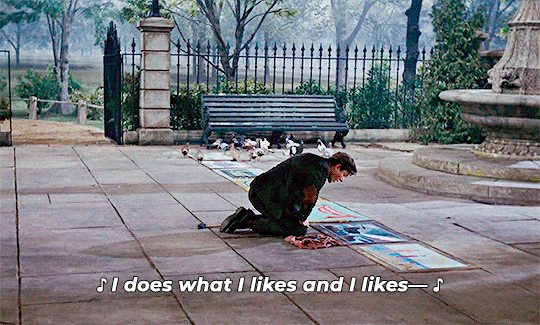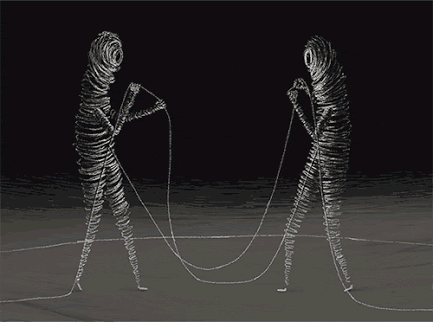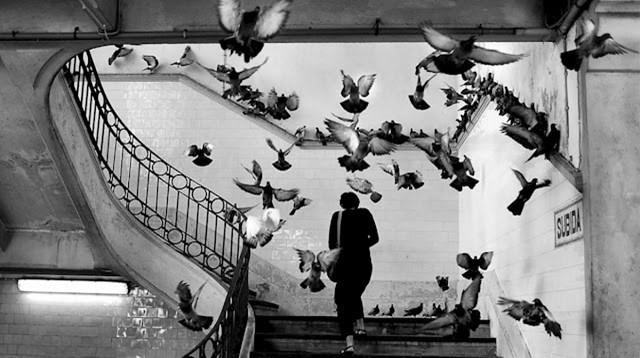
Orpheus Leading Eurydice from the Underworld
Camille Corot was
much beloved during his lifetime for his ethereal, dreamy landscapes that often
combined scenes from mythology with a very personal interpretation of nature
observed. Claude Monet himself said, "There is only one master here: Corot."
Camille Corot was
much beloved during his lifetime for his ethereal, dreamy landscapes that often
combined scenes from mythology with a very personal interpretation of nature
observed. Claude Monet himself said, "There is only one master here: Corot."
In this painting,
the fabled musician Orpheus--who beguiled the Greek gods to allow him to
retrieve his beloved wife, who had been fatally bitten by a snake--leads her
tenderly from the underworld. In ancient times, it was believed that the
deceased continued to exist as spirits, seen here gathered in small groups
beneath the delicate trees. Corot, a great music lover, has imbued this work
with a sense of melancholy lyricism that hints at the tragic end of the story:
Orpheus loses Eurydice forever when he turns to look at her before reaching the
world of the living.
The sense of
filtered reality is enhanced by Corot's extraordinarily subtle use of color. He
strikes a wistfully sweet tonal chord, carefully modulating a narrow range of
grays, greens, and blues. Orpheus Leading Eurydice from the Underworld looks
forward to the artist's signature paintings, the Souvenirs and Memoires, in
which Corot removes all narrative elements and lets his landscapes stand as
"pure" objects.
Wealthy U.S. Millennials and Gen Z Are Investing More in Alternative Assets Like Art
A new report by Bank of America finds that older and younger generations have very different ideas about the value of stocks and bonds versus alternative investment classes like art.
By Elisa Carollo • 06/21/24 7:00am
Much has changed since Bank of America (BAC) released its last
Private Bank Study of Wealthy Americans report in 2022. With the youngest Baby
Boomers approaching their 60th birthdays and a massive generational transfer of
wealth already begun, the study revealed that older and younger generations
have very different ideas about the value of stocks and bonds versus
alternative investment classes like art.
The 2024 report reveals how Millennials and Gen Z are
increasingly looking beyond the traditional markets to build and preserve
wealth: alternative and ‘pleasure’ assets account for 17 percent of their
portfolios, compared to 5 percent allocated by older investors. The study found
that 65 percent of all respondents were interested in collectible assets, but
among those under 44, it was 94 percent.
Millennials and Gen Z are at least two times more likely than
older generations to collect watches (46 percent), wine or spirits (36
percent), rare or classic cars (32 percent), sneakers (30 percent) and antiques
(30 percent). Additionally, younger wealthy Americans are far more likely to be
“very interested” (18 percent) or “somewhat interested” (25 percent) in owning
art when compared to wealthy Americans over 44, with only 2 percent “very
interested” and 15 percent “somewhat interested.” The study also revealed that
93 percent of respondents plan to allocate more of their investment dollars to
alternatives in the next few years.
When it comes to art in particular, older generations are now
looking to pass their holdings to the next generation, with 6 percent of
collectors 44 years of age or older saying it was “very likely” they would sell
work from their art collections in the next year. “We’re living through a
period of great social, economic and technological change alongside the
greatest generational transfer of wealth in history,” said Katy Knox, president
of Bank of America Private Wealth, in a statement.
We can identify this as occurring over the past two years,
with significant art collections coming up for auction and some postwar artists
experiencing disappointing results, with the classic white male artists now
seen as less relevant and appealing to newer generations. Art market and
auction professionals are increasingly thinking differently about the kinds of
art that will pass the test of time and meet the changing tastes and
sensibilities of the next generation of collectors.
A report conducted last year by Sotheby’s and ArtTactic found
that Boomers (born between 1946 and 1964) accounted for 40 percent of bids on
$1 million-plus art in 2022, down from 48 percent in 2018. Last May, we saw
relevant works by artists including Frank Stella and Richard Diebenkorn fail to
meet expectations. Other underperforming lots included works by Georges Braque
and Sam Francis, which were withdrawn before the auction, and Pablo Picasso’s
magnificent Femme au chapeau (1939), which was estimated to sell for between $6
million and $8 million but failed to attract a buyer.
One looming concern is that art owned by members of the Boomer
generation, which has been overrepresented among art buyers, won’t resonate
with younger art collectors. The Bank of America report reveals Millennials and
Gen Z are much more willing to dynamically think about art in their wealth
management strategy, with 28 percent considering using art as collateral for
loans, and when members of these generational cohorts inherit art, they’re much
more likely to sell and then buy something that speaks more to their personal
tastes.
It’s not just about the investment: emotional factors are also
crucial drivers for the younger generations of collectors, and in the decisions
of wealthy Millennials and Gen Z investors,
86 percent consider sentimental value in addition to economic value.
Perhaps for this reason, they are also interested in philanthropy, even though
this is more commonly associated with those who come from inherited wealth.
I love B&W
enri Cartier-Bresson
In photography, the smallest thing can be a great subject. The little human detail can become a leitmotiv.— Henri Cartier-Bresson
“Constant new discoveries in chemistry
and optics are widening considerably our field of action. It is up to us to
apply them to our technique, to improve ourselves, but there is a whole group
of fetishes which have developed on the subject of technique. Technique is
important only insofar as you must master it in order to communicate what you
see... The camera for us is a tool, not a pretty mechanical toy. In the precise
functioning of the mechanical object perhaps there is an unconscious
compensation for the anxieties and uncertainties of daily endeavor. In any
case, people think far too much about techniques and not enough about seeing.” Henri
Cartier-Bresson on technical aspects of photography
By John William Tuohy
Henri Cartier-Bresson (August 22, 1908 –
August 3, 2004) was a French humanist photographer. Humanist Photography, also
known as the School of Humanist Photography, manifests the Enlightenment
philosophical system in social documentary practice based on a perception of
social change.
It emerged in the mid-twentieth-century
and is associated most strongly with Europe, particularly France, where the
upheavals of the two world wars originated, though it was a worldwide movement.
It can be distinguished from
photojournalism, with which it forms a sub-class of reportage, as it is
concerned more broadly with everyday human experience, to witness mannerisms
and customs, than with newsworthy events, though practitioners are conscious of
conveying particular conditions and social trends, often, but not exclusively,
concentrating on the underclasses or those disadvantaged by conflict, economic
hardship or prejudice. Humanist photography "affirms the idea of a
universal underlying human nature".
Jean Claude Gautrand describes humanist
photography as: a lyrical trend, warm, fervent, and responsive to the
sufferings of humanity [which] began to assert itself during the 1950s in
Europe, particularly in France ... photographers dreamed of a world of mutual
succor and compassion, encapsulated ideally in a solicitous vision.
Photographing on the street or in the
bistro primarily in black‐and‐white in available light with the popular
small cameras of the day, these image-makers discovered what the writer Pierre
Mac Orlan (1882-1970) called the 'fantastique social de la rue' (social
fantasticality of the street)and their style of image making rendered romantic
and poetic the way of life of ordinary European people, particularly in Paris.
Cartier-Bresson considered a master of candid
photography, and an early user of 35 mm film. He pioneered the genre of street
photography and viewed photography as capturing a decisive moment.
Cartier-Bresson was one of the founding
members of Magnum Photos in 1947. In the 1970s he took up drawing—he had
studied painting in the 1920s.
Although Cartier-Bresson became frustrated
with Lhote's "rule-laden" approach to art, the rigorous theoretical
training later helped him identify and resolve problems of artistic form and
composition in photography.
In the 1920s, schools of photographic
realism were popping up throughout Europe, but each had a different view on the
direction photography should take. The Surrealist movement, founded in 1924,
was a catalyst for this paradigm shift[vague]. Cartier-Bresson began
socializing with the Surrealists at the Café Cyrano, in the Place Blanche. He
met a number of the movement's leading protagonists and was drawn to the
Surrealist movement's technique of using the subconscious and the immediate to
influence their work.
Cartier-Bresson matured artistically in
this stormy cultural and political atmosphere. But, although he knew the
concepts, he couldn't express them; dissatisfied with his experiments, he
destroyed most of his early paintings.
Cartier-Bresson almost always used a
Leica 35 mm rangefinder camera fitted with a normal 50 mm lens, or occasionally
a wide-angle lens for landscapes. He often wrapped black tape around the
camera's chrome body to make it less conspicuous. With fast black and white
film and sharp lenses, he was able to photograph events unnoticed. No longer
bound by a 4×5 press camera or a medium format twin-lens reflex camera,
miniature-format cameras gave Cartier-Bresson what he called "the velvet
hand...the hawk's eye."
He never photographed with flash, a
practice he saw as "impolite...like coming to a concert with a pistol in
your hand."
He believed in composing his photographs
in the viewfinder, not in the darkroom. He showcased this belief by having
nearly all his photographs printed only at full-frame and completely free of
any cropping or other darkroom manipulation. He insisted that his prints be
left uncropped so as to include a few millimeters of the unexposed negative
around the image area, resulting in a black frame around the developed picture.
Cartier-Bresson worked exclusively in
black and white, other than a few unsuccessful attempts in color.
He started a tradition of testing new
camera lenses by taking photographs of ducks in urban parks. He never published
the images but referred to them as 'my only superstition' as he considered it a
'baptism' of the lens.
Cartier-Bresson is regarded as one of the
art world's most unassuming personalities. He disliked publicity and exhibited
a ferocious shyness since his days of hiding from the Nazis during World War
II. Although he took many famous portraits, his face was little known to the
world at large. This, presumably, helped allow him to work on the street
undisturbed. He denied that the term "art" applied to his
photographs. Instead, he thought that they were merely his gut reactions to
fleeting situations that he had happened upon.




.jpg)










%201839_grKyx__please_credit%5Bpalette.fm%5D.jpg)







.jpg)










.jpg)
.jpg)













